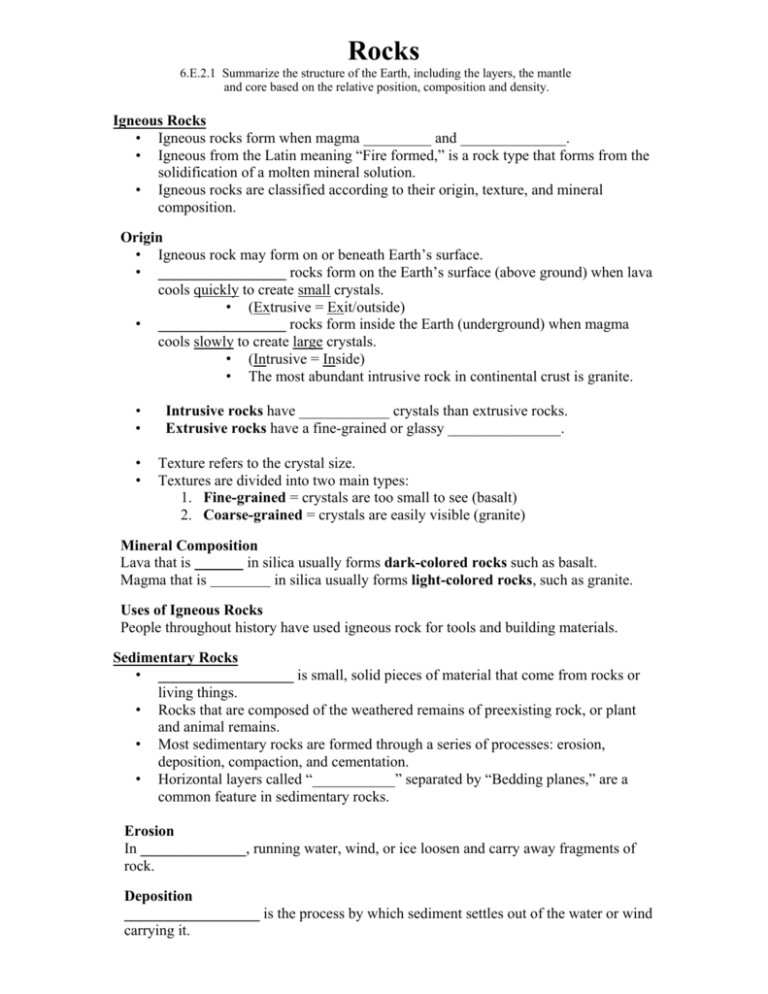Grouping Rocks
advertisement

Rocks 6.E.2.1 Summarize the structure of the Earth, including the layers, the mantle and core based on the relative position, composition and density. Igneous Rocks • Igneous rocks form when magma _________ and ______________. • Igneous from the Latin meaning “Fire formed,” is a rock type that forms from the solidification of a molten mineral solution. • Igneous rocks are classified according to their origin, texture, and mineral composition. Origin • Igneous rock may form on or beneath Earth’s surface. • _________________ rocks form on the Earth’s surface (above ground) when lava cools quickly to create small crystals. • (Extrusive = Exit/outside) • _________________ rocks form inside the Earth (underground) when magma cools slowly to create large crystals. • (Intrusive = Inside) • The most abundant intrusive rock in continental crust is granite. • • • • Intrusive rocks have ____________ crystals than extrusive rocks. Extrusive rocks have a fine-grained or glassy _______________. Texture refers to the crystal size. Textures are divided into two main types: 1. Fine-grained = crystals are too small to see (basalt) 2. Coarse-grained = crystals are easily visible (granite) Mineral Composition Lava that is in silica usually forms dark-colored rocks such as basalt. Magma that is in silica usually forms light-colored rocks, such as granite. Uses of Igneous Rocks People throughout history have used igneous rock for tools and building materials. Sedimentary Rocks • __________________ is small, solid pieces of material that come from rocks or living things. • Rocks that are composed of the weathered remains of preexisting rock, or plant and animal remains. • Most sedimentary rocks are formed through a series of processes: erosion, deposition, compaction, and cementation. • Horizontal layers called “___________” separated by “Bedding planes,” are a common feature in sedimentary rocks. Erosion In ______________, running water, wind, or ice loosen and carry away fragments of rock. Deposition __________________ is the process by which sediment settles out of the water or wind carrying it. Compaction The process that presses sediments together is __________________. Cementation Cementation is the process in which dissolved minerals crystallize and glue particles of sediment together. Examples: Conglomerate – cemented sand, silt, and pebble sediments. Sandstone – cemented quartz sand grains. Feels gritty. Unfilled spaces between grains make most sandstones porous and permeable to water. Types of Sedimentary Rocks Clastic Rocks Most sedimentary rocks are made up of broken pieces of other rocks. A ___________ rock is a sedimentary rock that forms when rock fragments are squeezed together. Organic Rocks Not all sedimentary rocks are made from particles of other rocks. ____________ rock forms where the remains of plants and animals are deposited in thick layers. “Organic” once were part of living things or were made by living things. Ex.) coal & limestone Chemical Rocks When minerals that dissolved in a solution crystallize, _______________ rock forms. Ex.) Limestone can form when calcite that is dissolved in lakes, seas, or underground water comes out of solution and forms crystals. Uses of Sedimentary Rocks People have used sedimentary rocks through out history for many different purposes, including building materials and tools. Metamorphic Rocks • Metamorphic rocks ________ from HEAT and PRESSURE changing the original or parent rock into a completely new rock. • The parent rock can be either sedimentary, igneous, or even another metamorphic rock. • Every metamorphic rock is a rock that has changed its form. • The deeper a rock is buried in the crust, the greater the pressure on that rock. Under high temperature and pressure many times greater than Earth’s surface, the minerals in a rock can be changed into other minerals. The rock has become a metamorphic rock. Types of Metamorphic Rocks Geologists classify metamorphic rocks according to the arrangement of the _________ that make up the rocks. Foliated Rocks Metamorphic rocks that have their grains arranged in parallel layers or bands are said to be _____________. Nonfoliated Rocks Mineral grains are arranged ______________. Uses of Metamorphic Rock Certain metamorphic rocks are important materials for building and sculpture. _______ and __________ are two of the most useful metamorphic rocks.





